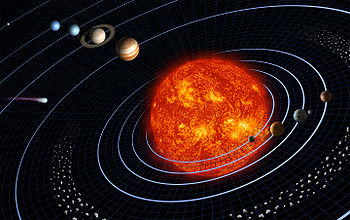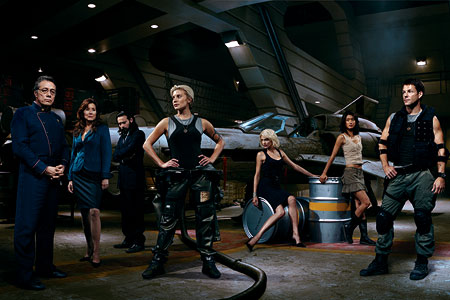GRAVITY:
IN
ALL THE WRONG PLACES
If there is one aspect of physics we are all very aware of, it's
gravity. No matter where you are on the Earth's surface, there is
always a force of gravity acting upon you. Isaac Newton even discovered
the law of universal gravity, showing that the force of gravitation
between two objects can be expressed by the equation:
F = G(m1m2)/r2
On earth, the force of gravitation (Fg), depends on Newton's
gravitational constant, the mass of each object (you and the planet),
as well as the distance between the two objects. Since this force has
to do with the distance between the two objects, a person in orbit will
be effected much less by the gravity of earth than someone on the
ground.
This has been shown by many space
missions, where space is shown to have essentially no gravity at all.
Many science fiction films ignore this, usually since filming in space
is close to ridiculously impossible. Where some writers account for
gravity with very advanced technologies that induce gravity, other such
as Battlestar Galactica forget to take care of our beloved laws of
physics. In the Battlestar Galactica series, characters are shown in
space where there is obviously negligible gravity, yet still pulled
down to the floor of the giant spacecraft.
Now, how could this be even close to possible? There are ways to create
artificial gravity, without incredibly advanced technology. By using a
rotation, a force can be created that appears to be gravity. As a
spacecraft spins, objects inside it want to travel in a straight line
due to inertia. This appears to be gravity since everything inside that
spacecraft can be seen as an object trying to travel in a straight line.
Hanging out, ignoring the lack of gravity.
Our second possibility is acceleration. The basic idea can be observed
when you slam the gas peddle on your car and feel yourself pulled
into the seat, or when you hit the break and get pushed forward. In
theory, if you were to constantly accelerate a spacecraft, there would
be an artificial force of gravity observed. Is this in any way
probable? The problem lies, again, with the physics itself. In order to
maintain this artificial gravity, the spacecraft has to have a constant
acceleration, not velocity. And, unless you don't really have an end in
mind, you would need to decelerate before you get to your destination.
Thomas
Edwards
- Physics 211x - FH1 - 2010


